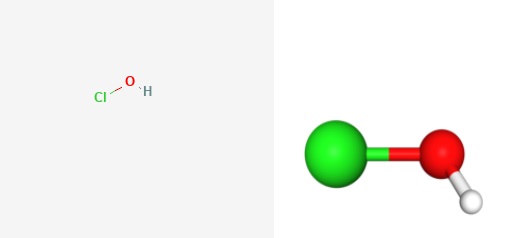What is Hypochlorous Acid?
HOCl is a frail corrosive with the synthetic name hypochlorous acid. It is additionally called hydrogen hypochlorite or chlorine hydroxide, or hypochlorous corrosive. French scientist Antoine Jerome Ballard found it in the year 1834. It is an oxyacid of chlorine.
It contains monovalent chlorine that capacities as a diminishing specialist or an oxidising specialist. It is an unsteady corrosive and functions as a human metabolite. It has a place with the group of receptive oxygen species and is a form corrosive of a hypochlorite.
Properties of Hypochlorous Acid
| HOCl |
Hypochlorous acid |
| Molecular weight |
52.457 g/mol |
| Number of hydrogen bond acceptor |
1 |
| Monoisotopic mass |
51.972 g/mol |
| Number of hydrogen bond donor |
1 |
Structure of Hypochlorous Acid
Uses:
-
Hypochlorous acid is productive to change alkenes over to chlorohydrins.
-
It is used in makeup, for example, infant items.
-
It is used in pools.
-
Its usage is to create adequate amounts of safe disinfectant.
-
It is also used in marine disinfection gadgets to change over seawater into HOCl.
Reactions:
- Hypochlorous corrosive mostly separates into the anion hypochlorite ClO− in watery arrangements. The following is the response:
HClO ⇌ ClO− + H+
- Hypochlorites are the salts of hypochlorous corrosive. One of the normal hypochlorites is sodium hypochlorite (NaClO), a functioning fixing in the dye.
- In standard conditions, hypochlorous acid is a more grounded oxidant when contrasted with chlorine.
2 HClO(aq) + 2 H+ + 2 e− ⇌ Cl2(g) + 2 H2O
Where, E = +1.63 V
- Hypochlorous corrosive responds with hydrochloric corrosive (HCl) to create chlorine gas:
HClO + HCl → H2O + Cl2
- Hypochlorous corrosive responds with amines to create chloramines alongside the water.
NH3 + HClO → NH2Cl + H2O
Weightage in Class 12:
In the chapter ‘The p-Block Elements,’ hypochlorous acid has been discussed with its reactions, properties, and valuable mass-bond. The chapter has a weightage of 19 marks.
FAQs on Hypochlorous Acid
Q. What will be the result when we add acids to the aqueous salts of hypochlorous acid?
Q. What will happen when hypochlorous acid reacts to amino acid?
Q. How hazardous is hypochlorous acid?
Q. How can we prepare the acid?
Q. How does hypochlorous acid treat as a bleaching agent?
Q. What is the pH value of hypochlorous acid?
Q. Can we produce hypochlorous acid?
Q. What does hypochlorous acid smell like?
News & Updates
Chemistry The p-Block Elements Exam
Student Forum
Popular Courses After 12th
Exams: BHU UET | KUK Entrance Exam | JMI Entrance Exam
Bachelor of Design in Animation (BDes)
Exams: UCEED | NIFT Entrance Exam | NID Entrance Exam
BA LLB (Bachelor of Arts + Bachelor of Laws)
Exams: CLAT | AILET | LSAT India
Bachelor of Journalism & Mass Communication (BJMC)
Exams: LUACMAT | SRMHCAT | GD Goenka Test
